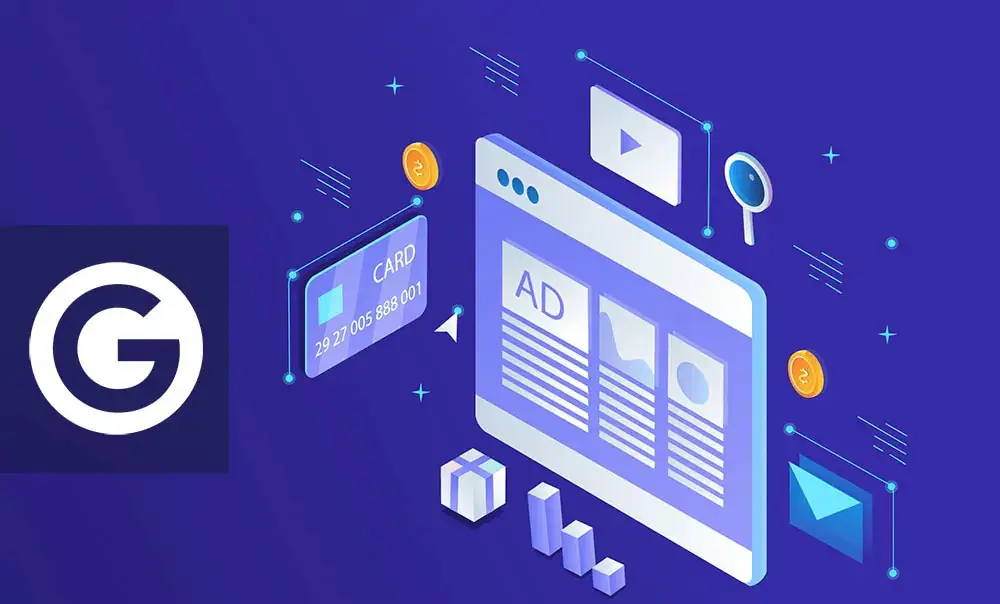
What Content Niche & AdSense Topics Produce The Highest Earnings?

Get helpful updates in your inbox
What Content Niche & AdSense Topics Produce The Highest Earnings?
We’ve previously discussed how to identify which content is your highest-earning and write about subjects that are likely to produce higher income. Now, I’ll show you how to specifically target high earning content and AdSense topics that will likely help you produce higher ad earnings on your website.
Below, I’ll show you how to study your existing landing page EPMV, most successful categories, author metrics, and related keywords to attract advertisers that can make you more money.
Additionally, I’ll show you a few cool hacks for finding out which relevant niche topics and AdSense topics produce the highest advertiser competition within your realm of expertise so you can go after content that will produce higher ad earnings.
I recently released a video for Ezoic Explains going over the topic, but I will walk you through step-by-step below.
How much money can you make from 1,000 website visits?
The amount of money you can make from 1,000 website visits can vary significantly depending on various factors, including the monetization method you use, the industry you’re in, the quality of your website traffic, and the effectiveness of your monetization strategy.
If you rely on display advertising as your primary monetization method, your earnings can range from a few dollars to a few hundred dollars per 1,000 website visits. The actual revenue will depend on factors such as the ad network you use, the ad placement, the click-through rate (CTR), the cost per click (CPC), and the overall performance of the ads.
Alternatively, if you generate revenue through affiliate marketing, the income potential can be higher. Affiliate marketing involves earning a commission for promoting products or services on your website and generating sales or leads. The amount you can earn per 1,000 visits will depend on the affiliate programs you’re part of, the commission rates, the conversion rate, and the average order value of the products or services you’re promoting.
It’s also worth mentioning that direct sales, subscriptions, sponsored content, and other revenue streams can contribute to your overall earnings. Therefore, it’s important to have a diversified monetization strategy to maximize your income.
Ultimately, the specific amount of money you can make from 1,000 website visits is difficult to determine without more details about your website, its niche, and your monetization methods. It’s recommended to experiment, analyze your data, and optimize your monetization strategies to increase your earnings over time.
How much money a website makes from display advertising or AdSense can vary dramatically. 1,000 visits could generate less than $1 USD or potentially $500 USD in display ad revenue depending on thousands of factors.
For advertisers, it’s no secret that certain audiences are just simply worth more than others. This means that certain topics connect specifically with audiences that advertisers covet (because of location, subject matter, etc.). Advertisers will bid more for impressions on sites that feature access to their coveted audience.
However, it’s not just about advertisers bidding more. It’s about competition for bids as well. You want content that attracts an audience that lots of advertisers want to bid on.
NOTE: Below I show how to hack Google Ads to find the highest earning topic for YOUR site

Simply writing about a topic won’t necessarily produce the audience that advertisers want; nor will it guarantee a whole lot of traffic. You need to be able to write content that attracts quality traffic (organic search is traditionally one of the best ways — here’s a way to get organic traffic to a keyword fast).
What’s more, Insurance, Medicine and Travel are all traditionally high-earning topics, but not every publisher can cater their content to those subjects.
For example, if you have a website on pets, there may not be a lot of opportunities to target topics about travel that your site can rank for in search results.
So Tyler, how do you target topics that produce good traffic, get the right audiences, and produce the highest earnings?
Using both Ezoic and Google Ads (just for the tools —you don’t have to start an ad campaign), I’ll show you how you can look more granularly at relevant topics in your content to see what will attract the highest-earning advertisers.
What categories and pages are the most valuable?
Knowing which categories and pages of your site produce the most ad earnings will provide the foundation of targeting high-earning advertisers already in your niche.
This is better than outright knowing which content categories produce the highest earnings for all of AdSense or for all display revenue. Targeting content based on this information may be a total waste of time unless your site is equipped to rank for those keywords or target the same audiences as sites currently reaping the benefits of those content categories.
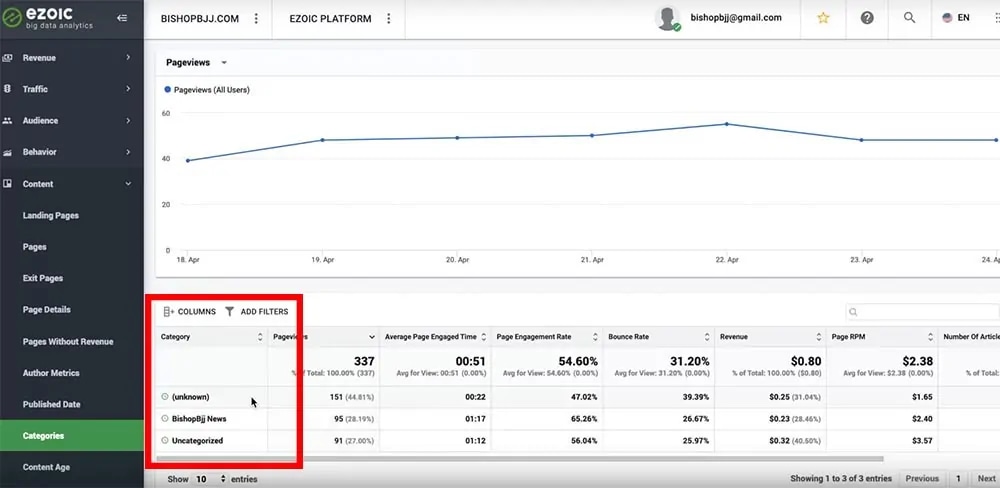
For Ezoic users, the free Big Data Analytics application provides metrics on page and website performance, user and traffic trends, and much more. I’ll be walking you through Big Data Analytics and finding your categories and pages using my small jiu jitsu website as a simple example.
In Big Data Analytics, navigate to the ‘Content’ tab and select ‘Categories.’ I never set any categories for this site, but most publishers will have a handful of categories. The top category with a name on this site is BishopBjj News.
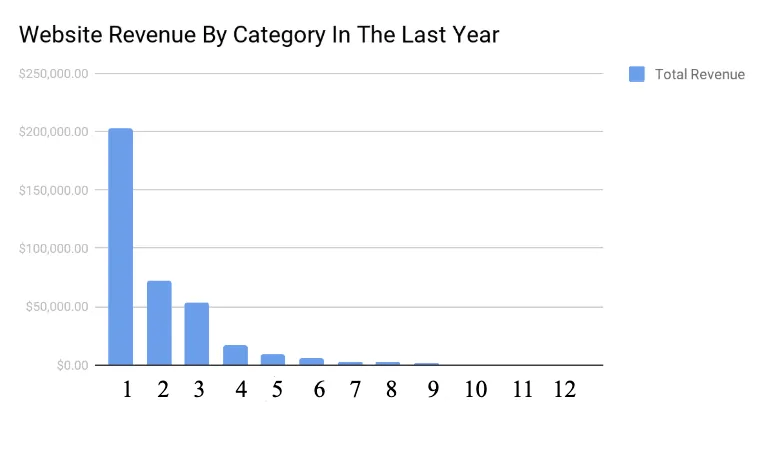
If you use categories already on your site, this will typically provide some massive clarity on which ones are driving most of your revenue. In the example above, you can see that this site has one category driving the vast majority of the revenue (and they have over (10,000 pages).
Now that I know a category to target (based on what my site’s data might tell me), I can look at individual pages of the website to determine which provide the most value.
We’re going to determine which pages are the highest-earning by studying which pages have the highest EPMV (earnings per mille visitors).
As we’ve discussed before, EPMV is a better metric to study than RPM because it measures the value of a user’s entire visit, rather than just a single page. EPMV gives you a better idea of what pages provide the most valuable to the rest of your website.
Navigate to the ‘Content’ tab and then ‘Landing Pages’ to see how your individual pages perform. Studying your landing pages can give you a lot of information on the performance of your website, including revenue and traffic data.
Drag the EPMV column all the way over to the left and then sort it by highest EPMV, as we did with page RPM.
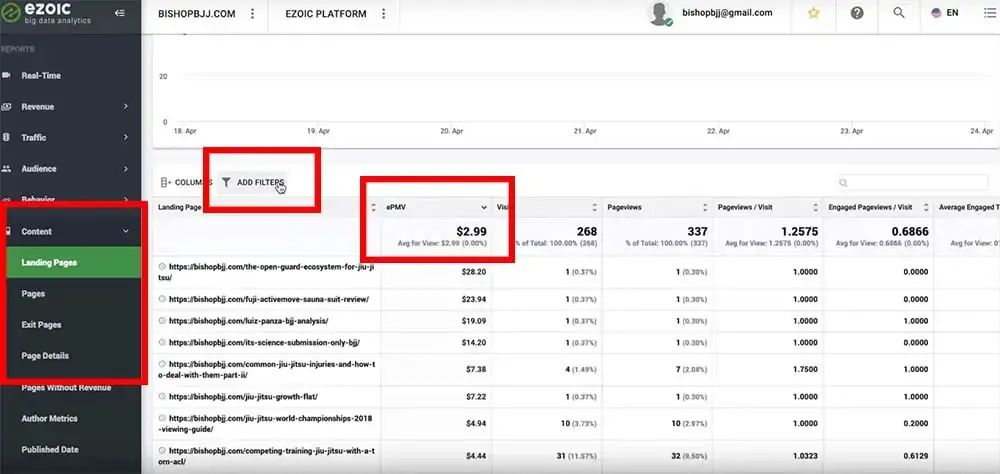
In this tab, we can observe data on our users. We can see if a user visited subsequent pages, if they spend more time on these pages, and if advertisers are bidding more on these pages.
This data can be further segmented by adding filters to the results.
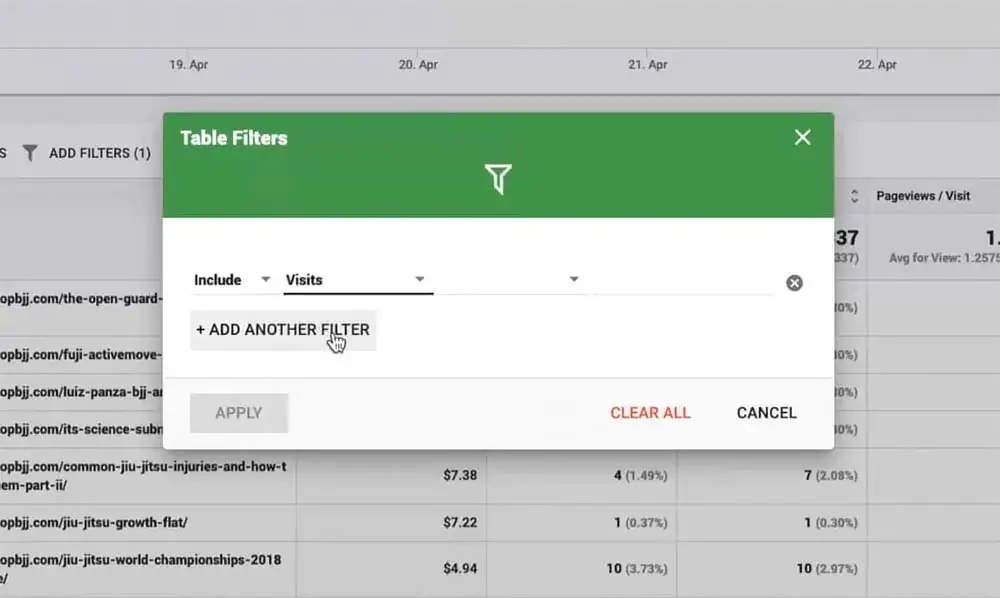
On my tiny jiu jitsu site, the highest-earning EPMV page makes $28.20 per visitor session, which is significantly higher than the average EPMV of $2.99. However, this is a bad sample size, because the column next to EPMV shows us that the page only has one visit.
To filter out any pages with low visit rate, simply click ‘Add Filters’ and then filter for the number of visitors. This will give you a better idea of your most-visited and highest earning pages.
In general, certain categories and pages tend to be more valuable in regards to ad revenue due to factors such as high demand, user engagement, and the likelihood of attracting advertisers. While the specific revenue potential can vary, here are some categories and page types that are often considered valuable:
- Finance and Investing: Pages related to personal finance, investing, banking, insurance, and credit cards tend to attract advertisers willing to pay a premium due to the high-value nature of the content and the potential for reaching financially engaged audiences.
- Technology and Gadgets: Technology-related content, including reviews, tutorials, and product comparisons, often attracts tech-savvy audiences who are more likely to engage with ads. Advertisers in the tech industry are often willing to pay higher rates to reach this audience.
- Health and Wellness: Pages focusing on health, fitness, nutrition, and well-being can be valuable due to the popularity of the niche and the potential for targeting audiences interested in products and services related to health and wellness.
- Travel and Tourism: Content related to travel destinations, accommodation, and tourism experiences can be lucrative because it attracts audiences actively seeking information about travel, making them more likely to engage with relevant advertisements.
- Lifestyle and Fashion: Pages dedicated to lifestyle, fashion, beauty, and related topics can be valuable as they often appeal to a wide audience and attract advertisers in industries such as apparel, cosmetics, and accessories.
- Home Improvement and DIY: Content related to home improvement, interior design, DIY projects, and home decor can be valuable due to the interest from audiences seeking inspiration, guidance, and products for their homes.
- Automotive: Pages focusing on automobiles, including car reviews, maintenance tips, and buying guides, can be valuable as they attract automotive enthusiasts and potential car buyers, which is of interest to advertisers in the automotive industry.
These categories are not exhaustive, and there are many other niches and page types that can be valuable depending on the audience, industry demand, and advertiser interest. It’s important to research your specific niche, analyze your target audience, and explore potential advertising partnerships to optimize your ad revenue.
Who is writing your best content?
Big Data Analytics also lets you see which author is producing the highest-earning and most-visited content. To do this, select ‘Author Metrics.’ In this example, I am the only author, but a publisher with multiple authors would have a list of names here (I know, my site isn’t the best example).
However, if I had multiple writers or website authors, this would allow me to see who is earning the highest page RPM as well as how many articles they’ve produced in a certain time window. You can also see average articles per week.
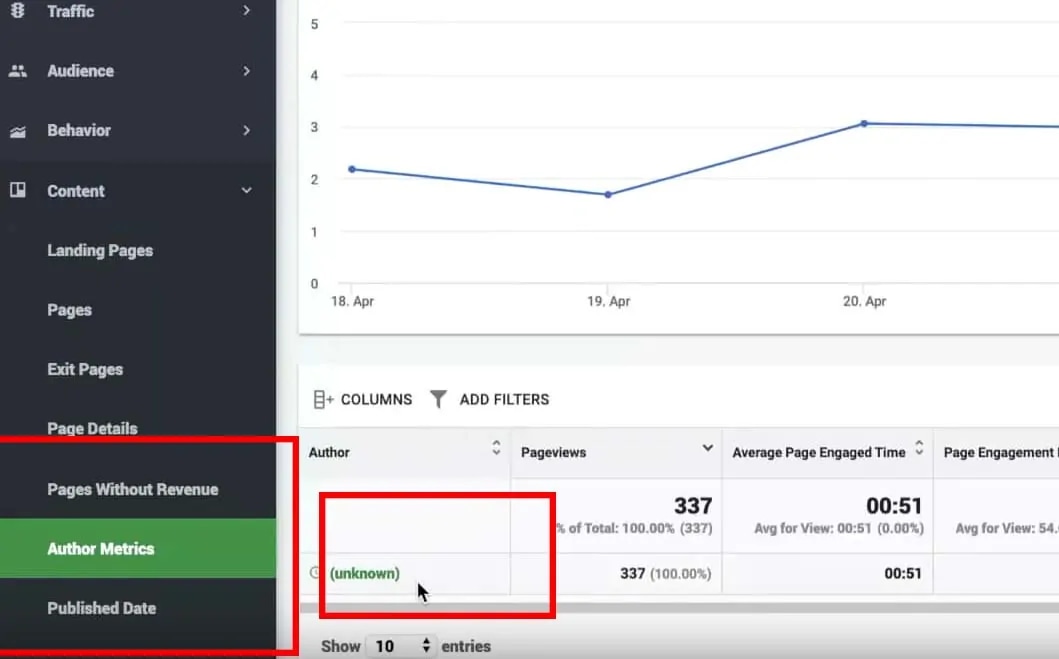
This gives you a good idea which authors produce your best content, what their best categories are, and the landing pages they’ve produced.
Altogether, this should make clearer what subjects are making you the most amount of money and which author is providing the highest-earning content. This could also help you better negotiate what you pay writers and justify paying them to write more as well.
Does the website revenue come from the page or the visit?
From here, it’s important to understand which articles on the site are earning the highest EPMV and why. Some sites will be making the bulk of their revenue from single page visits. This means that page is attracting a valuable audience and good engagement; thus advertisers bid for space on that page (see how engagement translates to higher ad earnings here).
The alternative is that visitors are landing on a page, but visiting multiple pages — generating lots of ad impressions (and higher earnings). Every site is different.
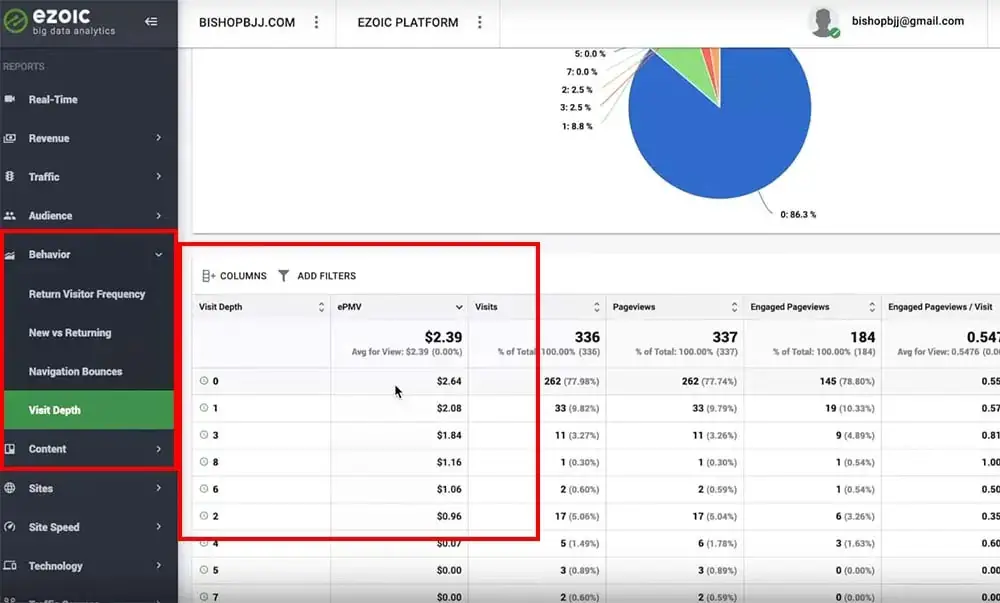
Is your site generating most of your earnings from the content where visitors land on a page and stay, or is it the landing pages that lead visitors to other pages?
In Big Data Analytics, the ‘Visit Depth’ tab will show you how many other pages a user visited after landing on a specific page.
In my example, visitors don’t typically navigate to other pages after visiting the highest-earning pages. There are a couple of instances where people visit up to eight pages but mostly, visitors land on a page and then leave the site. This shows us that we can’t really rely on the visitors to visit a bunch of extra pages, so we should really focus on engagement on the pages they are on.
Which niche pays the highest in AdSense and other non-Google networks?
Now that we know our most popular categories, the highest-earning content per session, which writers are producing that content, and how our audience behaves, we can begin writing content that will catch the attention of high-bidding advertisers.
Remember, the internet is filled with shady operators looking to make fast money off of writing about “the highest earning AdSense niche”. This is a bad strategy.
What you want to do is target the most relevant topics you can in your niche that are most likely to produce the highest advertiser bids and competition from multiple bidders.
To do this, I’ll use Google Ads to better understand how advertisers are behaving in my niche.
Step 1: Create a Google Ads account (don’t worry, you won’t have to use it)
This in no way means you have to begin advertising with Google Ads; we’re simply going to use the tools within it. It will ask you to set up a campaign and such, but you can create a fake campaign and just pause it. You can see here that the campaigns are ‘paused or removed.’
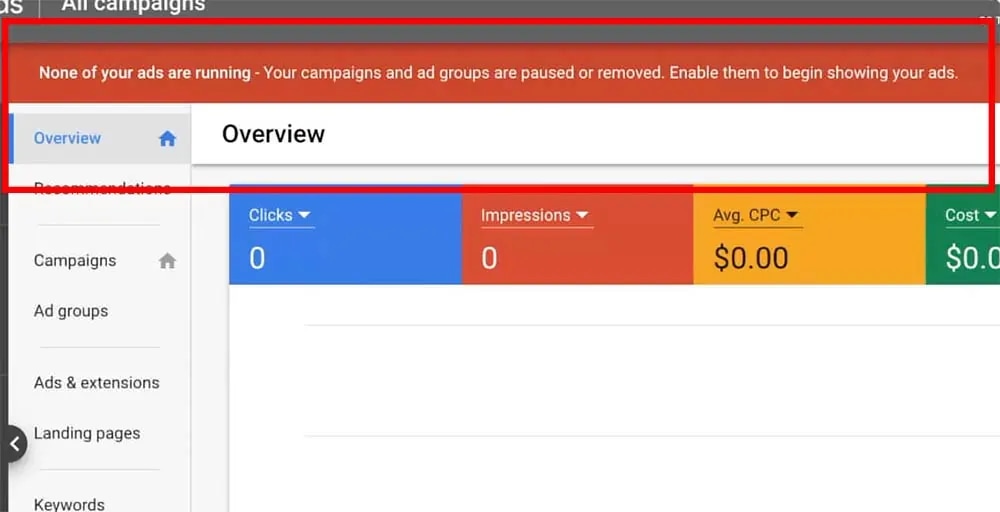
Step 2: The tool we want in Google Ads is the NEW Keyword Planner, which you can find in the left panel. Then, open the application.
As we found before, one of the best categories on the jiujitsu website was BishopBJJ news. There are many filters you can apply here, but I highly recommend selecting ‘Related ideas.’ This will provide information on topics similar to jiujitsu news but not quite as broad.
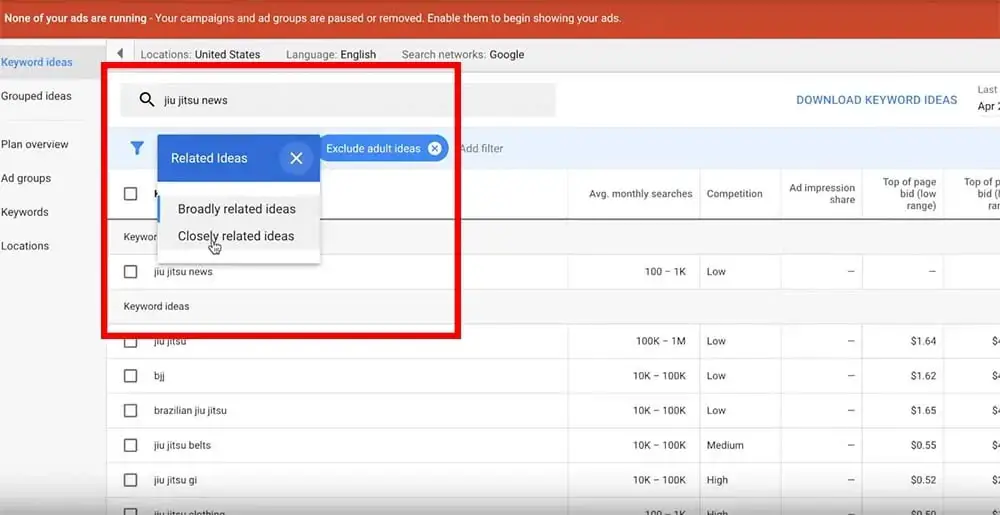
If you have a topic that is very broad, like jiu jitsu news, I would select ‘Broadley related ideas.’ If your content is a bit more specific, such as musical artists, you may want to select ‘Closely related ideas.’
There are many filters you can include, such as excluding adult ideas.
Step 3: I can see keywords associated with different monthly searches, how competitive they are, the ad impression share, and the top-of-page bid. Though these are search ads versus display ads, it gives us an idea of what advertisers are bidding the highest on.
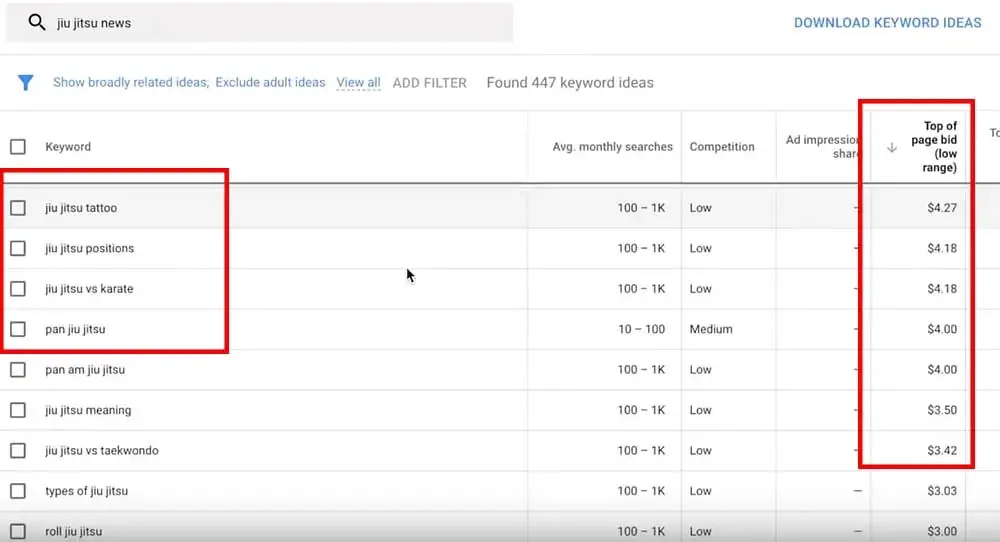
Step 4: From here, sort the results for ‘Top of page bid.’ As we can see, the highest-bidding topics are jiujitsu tattoo, jiujitsu positions, jiujitsu versus karate, and pan jiujitsu, which is a jiujitsu tournament.
This gives us me a good idea of what types of keywords and topics are the highest earning and how much competition there is for that keyword. These categories are a great place to start for creating content that high-earning advertisers will be attracted to.
EXAMPLE OF FINDING THE RIGHT TOPIC: Jiu jitsu tattoos would be an excellent topic to target for my website.
Using related keywords to target high-bidding advertisers
Using related keywords to target high-bidding advertisers is a strategy that aims to optimize ad revenue by attracting advertisers who are willing to pay higher rates for specific keywords. Here’s how it works:
- Keyword Research: Start by conducting thorough keyword research to identify high-value keywords within your niche. These are the keywords that advertisers are likely to bid on because they are relevant to their products or services and have a higher potential for generating conversions.
- Advertiser Analysis: Research and analyze the advertisers in your niche or industry. Look for patterns and identify the types of products or services that are typically associated with high-bidding advertisers. This will help you understand which keywords are more likely to attract those advertisers.
- Identify Related Keywords: Once you have a list of high-value keywords, expand it by identifying related keywords. These are variations or similar keywords that are relevant to your content and audience. For example, if your primary keyword is “smartphone reviews,” related keywords could include “best smartphones,” “top-rated smartphones,” or “latest smartphone models.”
- Analyze Keyword Bidding: Use keyword research tools or advertising platforms to analyze the bidding competition and average cost per click (CPC) for the keywords in your list. Look for keywords with higher CPCs, as they indicate that advertisers are willing to invest more money to target those keywords.
- Optimize Content and Ad Placement: Incorporate the related keywords strategically into your content, including titles, headings, meta tags, and throughout the body of your pages. This will help search engines understand the relevance of your content to those keywords. Additionally, consider optimizing ad placement to maximize visibility and engagement with the targeted keywords.
- Monitor and Adjust: Continuously monitor the performance of your keywords and ads. Pay attention to metrics such as click-through rate (CTR), conversion rate, and revenue generated. Adjust your strategy based on the data to optimize results over time.
Remember, this strategy requires a balance between user experience and ad optimization. Ensure that your content remains valuable, relevant, and engaging for your audience while implementing the related keywords and attracting high-bidding advertisers. Striking the right balance will help you maximize your ad revenue potential.
It’s worth noting that using related keywords alone may not guarantee high-bidding advertisers. Advertiser demand and competition can fluctuate, and the success of this strategy also depends on factors such as the size and engagement of your audience, the quality of your content, and your website’s overall visibility and reputation. Regular research, analysis, and adaptation are essential to stay ahead in the competitive advertising landscape.
We now have collected all of the data we need to begin structuring content that may appeal to high-earning advertisers:
- Categories
- High-earning EPMV pages
- Author metrics
- Valuable Keywords/Topics
There are a few ways to go about targeting these advertisers and it will vary for each publisher and topic. If your visit depth is deep for your highest EPMV articles, you may want to consider what you can do to produce a series of articles versus a single article on the topic. Or, it may make more sense for you to only write one article.
For my jiu jitsu website, the average EPMV was $2.39. As we determined earlier, jiujitsu is a very broad topic. In this example, I may begin to write content about jiujitsu tattoos. Whether or not I write a series on jiujitsu tattoos or a single article will depend on my audience and previous content’s performance.
In the end, it really all just comes back to using data and information to narrow down a subtopic that is earning slightly more than the average. By targeting these types of subjects, you could literally double the EPMV while also diversifying the content on your website.
If you have questions or comments, feel free to leave a comment and I’ll try to respond.

Tyler is an award-winning digital marketer, founder of Pubtelligence, CMO of Ezoic, SEO speaker, successful start-up founder, and well-known publishing industry personality.
Featured Content
Checkout this popular and trending content

Ranking In Universal Search Results: Video Is The Secret
See how Flickify can become the ultimate SEO hack for sites missing out on rankings because of a lack of video.
Announcement

Ezoic Edge: The Fastest Way To Load Pages. Period.
Ezoic announces an industry-first edge content delivery network for websites and creators; bringing the fastest pages on the web to Ezoic publishers.
Launch

Ezoic Unveils New Enterprise Program: Empowering Creators to Scale and Succeed
Ezoic recently announced a higher level designed for publishers that have reached that ultimate stage of growth. See what it means for Ezoic users.
Announcement
